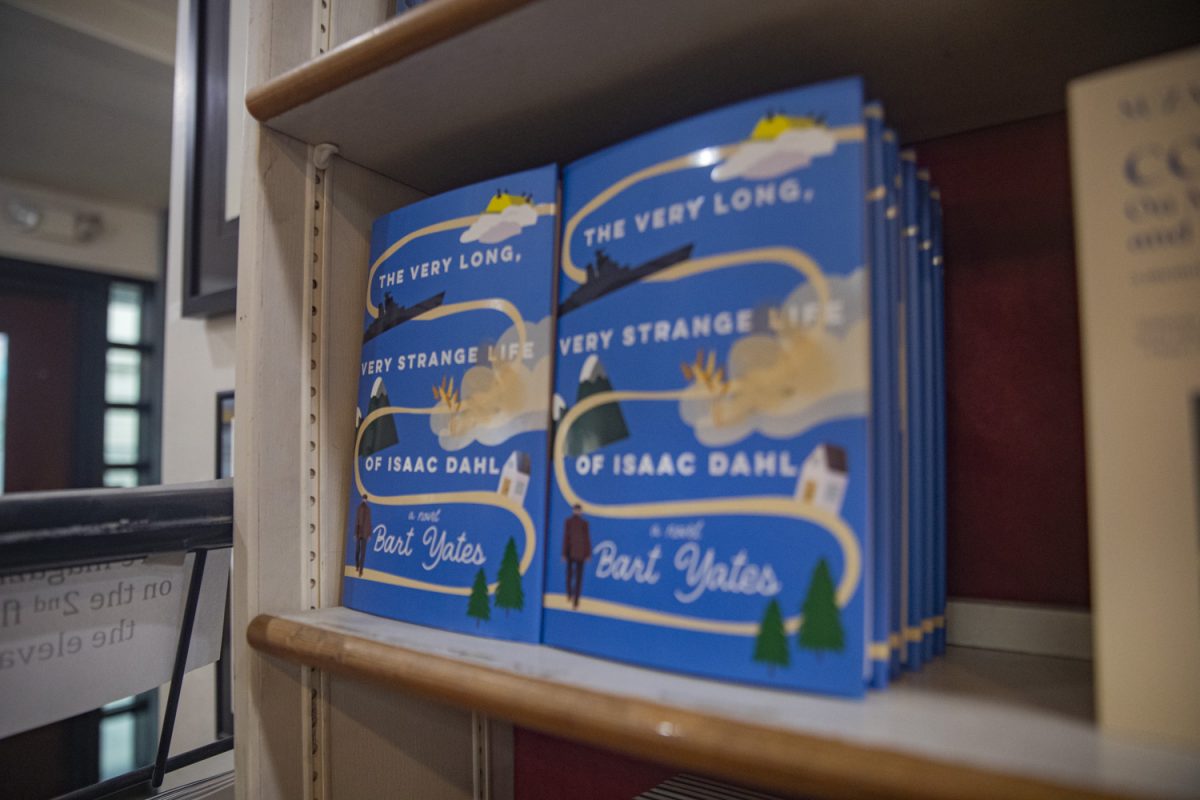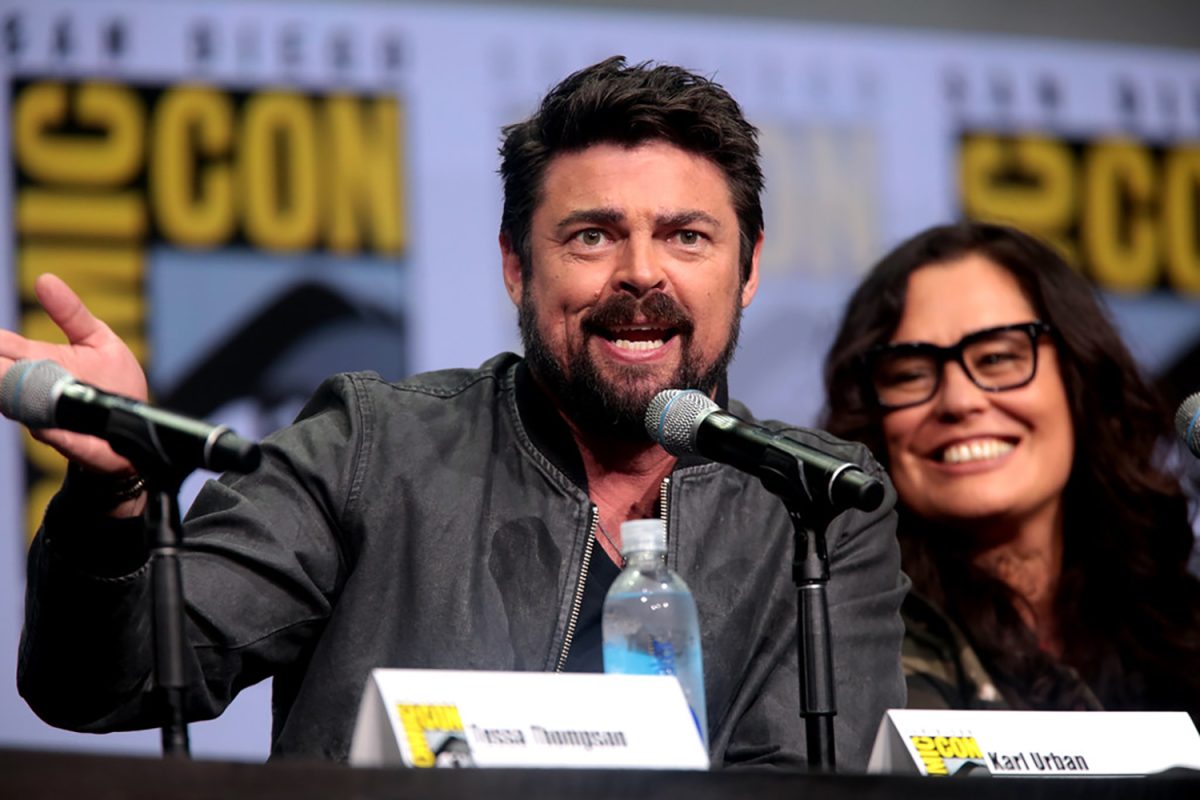
Surging forward as one, the two men attack, striking, sparring, and creating. In perfect synchronization, one moves down as the other moves up, left balanced by right, as the music keeps time. Though it could easily be a dance or a fight, it is painting.
With their quick dashes, the actors — playing the famous abstract-expressionist painter Mark Rothko and his assistant, Ken — smother every inch of the canvas with blood-red paint. The painting, so far from completion, already demands attention. Taller than either man, the canvas hangs center stage with red paint fanning outward on the floor from this focal point, smeared and dragged from the heavy falls of now-stained shoes. So begins Red.
Riverside Theater, 213 N. Gilbert St., will open the 2009 Tony-Award-winning play Red at 7:30 p.m. Friday. Performances will continue through the end of the month.
The show focuses on two years in the life of Rothko — who lived from 1903 to 1970 before eventually killing himself, and who was known for his use of color and light — exploring subjects beyond simple representations and experimenting in diverse media of art, including literature. The play is set during 1958-59, during which time Rothko was creating a series of paintings for the Four Seasons restaurant in New York City.
“Rothko was very much about his own work, about artistic integrity,” said Sam Osheroff, who will make his directorial début at Riverside with Red. “In the play, Rothko gets an assistant, who is fictional, and it covers their working on those pieces. More than that, it covers their relationship and how they go from employee-employer to something much deeper and the assistant starts to challenge Rothko.”
At the outset, assistant Ken certainly isn’t butting heads with Rothko. The passion behind every word Rothko speaks is staggering, at times knocking his assistant back with its force. “These pictures deserve compassion,” he says in the first act. “They live and die in the eye of the beholder.”
Feeble and nervous, Ken (Christopher Peltier) merely nods, continues to gaze at the images, then proceeds to do exactly as ordered by the living legend, trying to soak up as much knowledge as possible.
“My character says very little in the beginning of the play,” Peltier said. “Over the two-year time span of the play, he gradually builds thoughts and arguments, often referencing Rothko’s language, as he gains confidence in his points of view.
The process is one to which Peliter can relate, as plenty of research went into preparing for rehearsals. Red references approximately 20 artists, philosophers, authors, and works of art with which Rothko and his contemporaries would have been familiar. The average audience member, however, will not need to brush up on her or his art history.
“There’s no need to be intimidated by the subject matter or think because you don’t know about art that you won’t understand the play,” Peltier said. “The play is about a painter and his assistant, but at its core the story is about people learning from each other … about finding your voice and always having the highest standards for yourself.”
High standards are why Riverside waited to produce Red. Artistic Director Jody Hovland had eyed the script for three years but wanted to be sure she had the best possible artistic team and cast. This year, the stars aligned, and Red was added to the season schedule.
Hovland said she was, in her words, “jazzed” for the show.
“I think any time that we are allowed a peek into a world that may not be familiar to us; that’s one of the things the theater does best,” she said. “The chance to be so close to Rothko’s studio, mere feet away, to be privy to the life of that place, is such a unique experience for our audiences.”
Creating that studio was not taken lightly. Riverside’s stage was transformed, as usual, but for Red even the audience seating was integrated in the show. Tarps along the ground protect the carpet of the theater from paint splatter while also creating the feel of an art studio. The stage, now more of a workshop, houses a smorgasbord of canvases in various sizes, some brand-new and pearly white, others redone with bits of old paintings peeking through. On the stage, a table lies littered with paint brushes, rags, saws, a hammer, and, of course, paint. Red paint. Countless shades of red paint.
It may seem a bit extreme, but it’s quite likely Rothko would have needed everything in this room plus some.
“His work demands a lot of attention, a lot of time,” Osheroff said. “They’re not representations; they’re color blocks and tensions between colors and forms, so you don’t have easy access, as you would with a picture of a flower.”
Rothko’s work was further defined by a personal technique: painting in numerous layers; his images show colors shining through other colors, melding together and contributing to a truly individual masterpiece.
Watching the creation of the works represented on stage, Osheroff said, will grant greater access into this world.
“You see these two guys creating literally on stage, stretching canvas, building frames, mixing paint, priming a giant canvas, so it’s very active,” he said. “All these arguments and these conversations are grounded on stage in watching this master of his craft and his assistant create.”
It is not surprising that Rothko would discuss art so much as he works. Art was always at the forefront of Rothko’s mind, serving as his attempt to answer the deep questions of the world, the meaning of life.
“Rothko was a guy who could not separate his art from his thinking — his thoughts are in colors and images,” Osheroff said. “I don’t think there really are answers to those deeper questions. I mean, 10 years later Rothko killed himself because he couldn’t get to the bottom of it.”
He may not have found the answer to all he searched for, but Rothko provided answers, and further questions, during his career. His paintings reached vast audiences in his attempt to share his work, for art, Rothko believed, was the only way to thrive.
Red may be one step in keeping Rothko’s works alive.
“Rothko saw the world in colors, so red was life to him, black was decay, but it’s more complex than that,” Osheroff said. “Rothko suffered from depression. He also watched his friend Jackson Pollock drink himself to death. There’s a great line in there, he says, ‘We have art that we may not perish from truth. Pollock saw some truth and then he didn’t have art to protect him anymore. Who could survive that?’ If you boil it down, it’s despair versus survival.”
THEATER
What: Red






